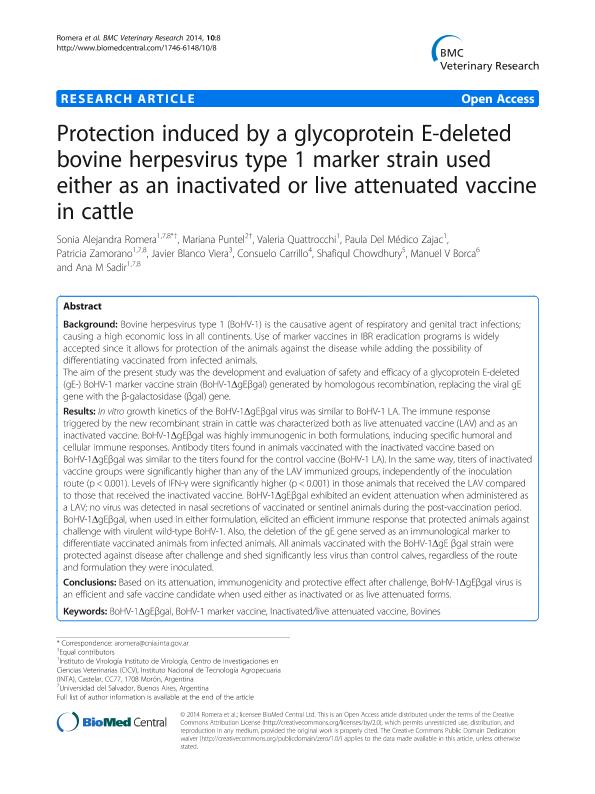Mostrar el registro sencillo del ítem
dc.contributor.author
Romera, Sonia

dc.contributor.author
Puntel, Mariana

dc.contributor.author
Quattrocchi, Valeria

dc.contributor.author
del Medico Zajac, Maria Paula

dc.contributor.author
Zamorano, Patricia Ines

dc.contributor.author
Blanco Viera, Javier
dc.contributor.author
Carrillo, Consuelo
dc.contributor.author
Chowdhury, Shafiqul
dc.contributor.author
Borca, Manuel V.
dc.contributor.author
Sadir, Ana M.
dc.date.available
2016-11-30T20:17:03Z
dc.date.issued
2014-01
dc.identifier.citation
Romera, Sonia; Puntel, Mariana; Quattrocchi, Valeria; del Medico Zajac, Maria Paula; Zamorano, Patricia Ines; et al.; Protection induced by a glycoprotein E-deleted bovine herpesvirus type 1 marker strain used either as an inactivated or live attenuated vaccine in cattle; Biomed Central; BMC Veterinary Research; 10; 1-2014; 1-12
dc.identifier.issn
1746-6148
dc.identifier.uri
http://hdl.handle.net/11336/8540
dc.description.abstract
BACKGROUND: Bovine herpesvirus type 1 (BoHV-1) is the causative agent of respiratory and genital tract infections; causing a high economic loss in all continents. Use of marker vaccines in IBR eradication programs is widely accepted since it allows for protection of the animals against the disease while adding the possibility of differentiating vaccinated from infected animals.The aim of the present study was the development and evaluation of safety and efficacy of a glycoprotein E-deleted (gE-) BoHV-1 marker vaccine strain (BoHV-1ΔgEβgal) generated by homologous recombination, replacing the viral gE gene with the β-galactosidase (βgal) gene. RESULTS: In vitro growth kinetics of the BoHV-1ΔgEβgal virus was similar to BoHV-1 LA. The immune response triggered by the new recombinant strain in cattle was characterized both as live attenuated vaccine (LAV) and as an inactivated vaccine. BoHV-1ΔgEβgal was highly immunogenic in both formulations, inducing specific humoral and cellular immune responses. Antibody titers found in animals vaccinated with the inactivated vaccine based on BoHV-1ΔgEβgal was similar to the titers found for the control vaccine (BoHV-1 LA). In the same way, titers of inactivated vaccine groups were significantly higher than any of the LAV immunized groups, independently of the inoculation route (p < 0.001). Levels of IFN-γ were significantly higher (p < 0.001) in those animals that received the LAV compared to those that received the inactivated vaccine. BoHV-1ΔgEβgal exhibited an evident attenuation when administered as a LAV; no virus was detected in nasal secretions of vaccinated or sentinel animals during the post-vaccination period. BoHV-1ΔgEβgal, when used in either formulation, elicited an efficient immune response that protected animals against challenge with virulent wild-type BoHV-1. Also, the deletion of the gE gene served as an immunological marker to differentiate vaccinated animals from infected animals. All animals vaccinated with the BoHV-1ΔgE βgal strain were protected against disease after challenge and shed significantly less virus than control calves, regardless of the route and formulation they were inoculated. CONCLUSIONS: Based on its attenuation, immunogenicity and protective effect after challenge, BoHV-1ΔgEβgal virus is an efficient and safe vaccine candidate when used either as inactivated or as live attenuated forms.
dc.format
application/pdf
dc.language.iso
eng
dc.publisher
Biomed Central

dc.rights
info:eu-repo/semantics/openAccess
dc.rights.uri
https://creativecommons.org/licenses/by/2.5/ar/
dc.subject
Bovine Herpesvirus
dc.subject
Vaccination
dc.subject
Recombinant Marker Vaccine
dc.subject
Attenuated Vaccine
dc.subject.classification
Ciencias Veterinarias

dc.subject.classification
Ciencias Veterinarias

dc.subject.classification
CIENCIAS AGRÍCOLAS

dc.subject.classification
Ciencias Veterinarias

dc.subject.classification
Ciencias Veterinarias

dc.subject.classification
CIENCIAS AGRÍCOLAS

dc.title
Protection induced by a glycoprotein E-deleted bovine herpesvirus type 1 marker strain used either as an inactivated or live attenuated vaccine in cattle
dc.type
info:eu-repo/semantics/article
dc.type
info:ar-repo/semantics/artículo
dc.type
info:eu-repo/semantics/publishedVersion
dc.date.updated
2016-11-29T12:42:29Z
dc.journal.volume
10
dc.journal.pagination
1-12
dc.journal.pais
Reino Unido

dc.journal.ciudad
Londres
dc.description.fil
Fil: Romera, Sonia. Instituto Nacional de Tecnologia Agropecuaria. Centro Nacional de Investigaciones Agropecuarias. Centro de Investigación de Ciencias Veterinarias y Agronomicas; Argentina. Universidad del Salvador; Argentina
dc.description.fil
Fil: Puntel, Mariana. Consejo Nacional de Investigaciones Científicas y Técnicas. Oficina de Coordinación Administrativa Parque Centenario. Instituto de Investigaciones Bioquimicas de Buenos Aires; Argentina. Fundación Instituto Leloir; Argentina
dc.description.fil
Fil: Quattrocchi, Valeria. Instituto Nacional de Tecnologia Agropecuaria. Centro Nacional de Investigaciones Agropecuarias. Centro de Investigación de Ciencias Veterinarias y Agronomicas; Argentina
dc.description.fil
Fil: del Medico Zajac, Maria Paula. Instituto Nacional de Tecnologia Agropecuaria. Centro Nacional de Investigaciones Agropecuarias. Centro de Investigación de Ciencias Veterinarias y Agronomicas; Argentina
dc.description.fil
Fil: Zamorano, Patricia Ines. Instituto Nacional de Tecnologia Agropecuaria. Centro Nacional de Investigaciones Agropecuarias. Centro de Investigación de Ciencias Veterinarias y Agronomicas; Argentina. Universidad del Salvador; Argentina. Consejo Nacional de Investigaciones Científicas y Técnicas; Argentina
dc.description.fil
Fil: Blanco Viera, Javier. Instituto Nacional de Tecnologia Agropecuaria. Centro Nacional de Investigaciones Agropecuarias. Centro de Investigación de Ciencias Veterinarias y Agronomicas; Argentina
dc.description.fil
Fil: Carrillo, Consuelo. USDA. Plum Island Animal Disease Center; Estados Unidos
dc.description.fil
Fil: Chowdhury, Shafiqul. Louisiana State University. Department of Pathobiological Sciences; Estados Unidos
dc.description.fil
Fil: Borca, Manuel V.. USDA. Plum Island Animal Disease Center; Estados Unidos
dc.description.fil
Fil: Sadir, Ana M.. Instituto Nacional de Tecnologia Agropecuaria. Centro Nacional de Investigaciones Agropecuarias. Centro de Investigación de Ciencias Veterinarias y Agronomicas; Argentina. Universidad del Salvador; Argentina. Consejo Nacional de Investigaciones Científicas y Técnicas; Argentina
dc.journal.title
BMC Veterinary Research

dc.relation.alternativeid
info:eu-repo/semantics/altIdentifier/url/https://bmcvetres.biomedcentral.com/articles/10.1186/1746-6148-10-8
dc.relation.alternativeid
info:eu-repo/semantics/altIdentifier/doi/http://dx.doi.org/10.1186/1746-6148-10-8
dc.relation.alternativeid
info:eu-repo/semantics/altIdentifier/url/https://www.ncbi.nlm.nih.gov/pmc/articles/PMC3896737/
Archivos asociados
